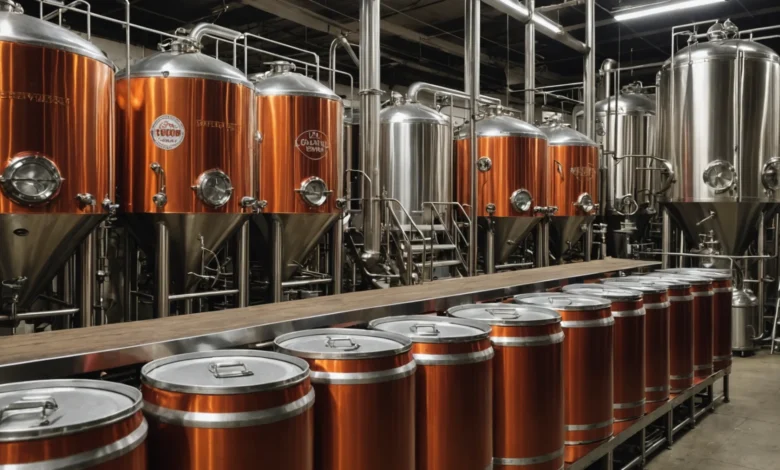Is a Brewery a Good Investment?

Investing in a brewery may sound appealing to entrepreneurs and beer enthusiasts alike, especially given the recent surge in the popularity of craft beer. However, the question remains: Is a brewery a good investment? To answer this, potential investors need to consider a range of factors, from startup costs and operational challenges to market demand and profitability potential. This article will explore these aspects and address some of the most common questions related to investing in breweries.
Micet Craft Brewing Equipment Turnkey Solutions – Micet Group
1. The Growth of the Craft Beer Industry
The craft beer industry has experienced significant growth over the past decade, with thousands of new breweries opening across the United States, Europe, and beyond. The appeal of craft beer lies in its variety, authenticity, and artisanal nature, making it a popular alternative to mass-produced beer. According to the Brewers Association, craft breweries have steadily increased their market share and are estimated to hold over 25% of the U.S. beer market.
Given the increasing consumer interest in craft beers and the strong market demand, investing in a brewery may seem like a lucrative opportunity. However, the brewing industry is also highly competitive, with numerous players entering the market each year. While some breweries thrive, others struggle to find a sustainable niche. Understanding the broader market landscape is essential before deciding if a brewery is a good investment.
2. Initial Costs and Capital Requirements
Investing in a brewery requires significant capital upfront. The initial costs of starting a brewery can vary widely depending on the size and scale of the operation. Typical startup costs for a brewery can include:
- Equipment: Brewing equipment represents one of the largest capital expenditures. For a small microbrewery, the cost of fermenters, brew kettles, and bottling lines may range from $100,000 to $500,000. Larger operations can cost well over $1 million.
- Licensing and Permits: Breweries must adhere to local, state, and federal regulations, requiring various permits and licenses to legally produce and sell alcohol. The cost of licensing can vary by region, but it is often a significant upfront investment.
- Location and Renovations: Renting or purchasing a suitable facility is another major expense. Renovating a space to accommodate brewing equipment, storage, a taproom, and customer seating (if operating as a brewpub) can add to the initial costs.
- Raw Materials: Breweries require large quantities of ingredients like malt, hops, yeast, and water. For new breweries, purchasing these materials in bulk can be costly, and the quality of ingredients can impact both product quality and profitability.
- Staffing: Hiring skilled brewers, taproom staff, salespeople, and marketing professionals is necessary to run a successful brewery. Staffing costs can add up quickly, especially for larger-scale operations.
The substantial capital requirements mean that investors must be prepared for a lengthy period before they begin to see a return on their investment. In most cases, it can take two to three years (or longer) for a brewery to become profitable.
3. Operating Costs and Margins
Once a brewery is up and running, it faces ongoing operating costs that must be carefully managed to maintain profitability. These costs include:
- Utilities: Brewing beer requires large amounts of water and electricity. Utilities can represent a significant portion of a brewery’s monthly expenses.
- Ingredients: The cost of raw materials fluctuates based on the types of beer being produced. Premium ingredients for specialty craft beers will generally be more expensive than those used for standard brews.
- Maintenance and Repairs: Brewing equipment requires regular maintenance to ensure smooth operation. Unexpected breakdowns or repairs can add to operating expenses.
- Distribution: If the brewery distributes its products to bars, restaurants, or retail outlets, distribution costs (such as packaging, logistics, and transportation) will cut into margins.
- Marketing and Branding: Successful breweries invest in strong branding and marketing to attract customers. These efforts can include social media campaigns, taproom promotions, partnerships with local bars, and participation in beer festivals.
Breweries typically operate on thin profit margins. According to industry experts, the average profit margin for breweries ranges from 20% to 45%, depending on the size and type of operation. Brewpubs, which sell directly to customers on-site, tend to enjoy higher profit margins compared to breweries that distribute their products. However, brewpubs also face higher costs associated with maintaining a taproom and providing a positive customer experience.
4. Market Trends and Competition
One of the primary risks associated with investing in a brewery is the highly competitive nature of the craft beer market. While the industry has seen rapid growth, it has also become saturated with new entrants, making it challenging for new breweries to establish themselves.
Market trends in the beer industry can also shift rapidly. For example, the rising popularity of hard seltzers and non-alcoholic beverages has led to increased competition for consumer attention. While craft beer remains popular, brewers must stay ahead of trends and innovate to keep their product offerings fresh and appealing.
Another factor to consider is the regional demand for craft beer. While some areas have a strong craft beer culture with a loyal customer base, other regions may have limited interest in artisanal beer. Conducting thorough market research to assess local demand and competition is critical to determining whether a brewery will succeed in a specific location.
5. Revenue Streams and Diversification
Breweries can generate revenue from several different streams, which can help mitigate risk and enhance profitability. Common revenue streams include:
- On-site Taproom Sales: Many breweries operate taprooms where customers can sample and purchase beer directly from the source. Taproom sales typically offer higher profit margins because they eliminate the need for intermediaries like distributors and retailers.
- Distribution: By distributing beer to bars, restaurants, and liquor stores, breweries can reach a broader audience. However, distribution typically comes with lower margins due to transportation and packaging costs.
- Merchandise Sales: Breweries often sell branded merchandise such as t-shirts, hats, glassware, and other promotional items. These products can help build brand loyalty and provide an additional revenue stream.
- Events and Private Functions: Breweries can host private events, beer festivals, or tastings to generate extra revenue. Renting out the taproom or production space for corporate events or parties is another opportunity for income.
Diversifying revenue streams can improve the overall financial stability of a brewery and reduce dependence on beer sales alone.
6. The Role of Passion in the Brewing Industry
While profitability and return on investment are essential factors for any investor, the brewing industry also attracts entrepreneurs driven by passion. Many successful brewery owners started as homebrewers who wanted to turn their hobby into a business. A genuine love for brewing, coupled with a commitment to producing high-quality beer, can make a significant difference in a brewery’s long-term success.
However, passion alone is not enough to make a brewery a good investment. Investors must also approach the business with a strong understanding of the financial, operational, and regulatory challenges involved. Those who strike the right balance between passion and business acumen have the best chance of success.
7. Is a Brewery a Good Investment?
So, is a brewery a good investment? The answer depends on several key factors:
- Initial Capital: Investors must be prepared to make a substantial upfront investment in equipment, facilities, and licensing. Without sufficient capital, it will be challenging to scale the business.
- Market Research: Understanding the local market, customer preferences, and competition is essential. Breweries that fill a niche in the market are more likely to succeed.
- Operational Efficiency: Managing costs, controlling waste, and maintaining efficient production processes are critical to profitability.
- Passion and Innovation: Successful breweries are often founded by passionate entrepreneurs who are dedicated to producing exceptional beer. Innovation in beer styles, branding, and customer engagement can help differentiate a brewery from competitors.
For the right investor with a solid business plan and a deep appreciation for the craft beer industry, a brewery can be a rewarding and profitable venture. However, it is not without its challenges, and investors should carefully evaluate the risks and rewards before committing capital.
FAQs About Investing in Breweries
1. How much does it cost to start a brewery?
The cost to start a brewery can range from $100,000 for a small microbrewery to several million dollars for a larger commercial operation. The total investment depends on factors like equipment, location, licensing, and the scale of the business.
2. How long does it take for a brewery to become profitable?
It typically takes two to three years for a brewery to become profitable, though this can vary based on startup costs, operational efficiency, and market demand. Some breweries may take longer to break even if they face significant competition or high overhead.
3. What are the risks of investing in a brewery?
The primary risks include high startup costs, ongoing operating expenses, market saturation, and changing consumer preferences. Additionally, breweries must comply with a range of local, state, and federal regulations, which can be costly and time-consuming.
4. Can small breweries be profitable?
Yes, small breweries can be profitable, particularly if they focus on niche markets, operate efficiently, and maintain strong customer loyalty. Brewpubs, which sell beer directly to customers, often enjoy higher profit margins than breweries that rely solely on distribution.
Conclusion,
while investing in a brewery has the potential to be a rewarding and profitable venture, it requires careful planning, substantial capital, and a deep understanding of the industry. For investors who are passionate about craft beer and willing to navigate the complexities of the business, a brewery can indeed be a good investment. However, success is not guaranteed, and those considering this path should approach it with realistic expectations and a long-term commitment.





